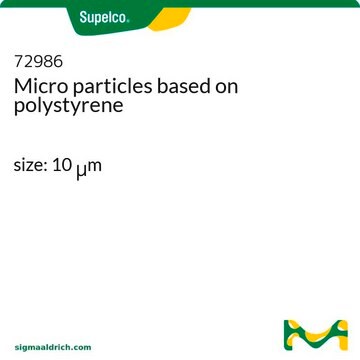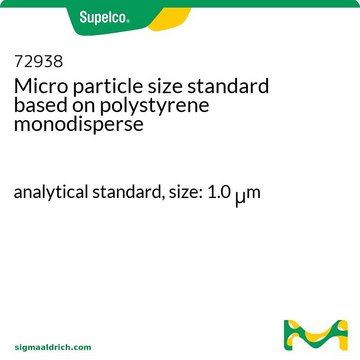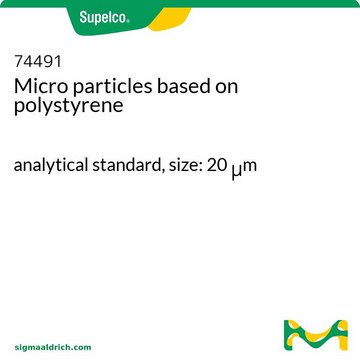89904
Micro particles based on polystyrene
size: 1 μm
Synonym(s):
Latex beads from PS
Sign Into View Organizational & Contract Pricing
All Photos(1)
About This Item
Recommended Products
form
aqueous suspension
crosslinking
0 % cross-linked
concentration
10% (solids)
particle size
1 μm std dev <0.1 μm, coeff var <5%
density
1.05 g/cm3
storage temp.
2-8°C
Looking for similar products? Visit Product Comparison Guide
General description
Micro Particles or Latex Beads, commonly known as polystyrene microparticles, are negatively charged colloidal particles. The microparticles are produced through a polymerization reaction of styrene under controlled conditions. The conducive environment of the reaction induces spontaneous coalescent bead formation. Micro Particles or Latex beads are supplied in aqueous solutions composed of polymer particles with water. Polystyrene′s refractive index at 589 nm is 1.5905 and 1.602 at 486 nm.
Application
Micro Particles or Latex Beads is used for a wide variety of applications like:
- Electron Microscopy.
- Cell Counter Calibration.
- Immunodiagnostics, especially for latex agglutination tests, and
- Phagocytosis Research.
Analysis Note
For every lot exact values of particle size and standard deviation are determined with an accuracy of 0.01 μm using a Coulter Multisizer.
Other Notes
Template for preparing hollow spheres by self-organized deposition of nanoparticles. The PS core dissolves in THF
Related product
Product No.
Description
Pricing
Storage Class
11 - Combustible Solids
wgk_germany
WGK 3
flash_point_f
Not applicable
flash_point_c
Not applicable
ppe
Eyeshields, Gloves, type N95 (US)
Certificates of Analysis (COA)
Search for Certificates of Analysis (COA) by entering the products Lot/Batch Number. Lot and Batch Numbers can be found on a product’s label following the words ‘Lot’ or ‘Batch’.
Already Own This Product?
Find documentation for the products that you have recently purchased in the Document Library.
Customers Also Viewed
Diana El Khoury et al.
Beilstein journal of nanotechnology, 9, 2999-3012 (2018-12-29)
The unusual properties of nanocomposites are commonly explained by the structure of their interphase. Therefore, these nanoscale interphase regions need to be precisely characterized; however, the existing high resolution experimental methods have not been reliably adapted to this purpose. Electrostatic
Caruso et al.
Science (New York, N.Y.), 282(5391), 1111-1114 (1998-11-06)
Hollow silica and silica-polymer spheres with diameters between 720 and 1000 nanometers were fabricated by consecutively assembling silica nanoparticles and polymer onto colloids and subsequently removing the templated colloid either by calcination or decomposition upon exposure to solvents. Scanning and
Our team of scientists has experience in all areas of research including Life Science, Material Science, Chemical Synthesis, Chromatography, Analytical and many others.
Contact Technical Service










